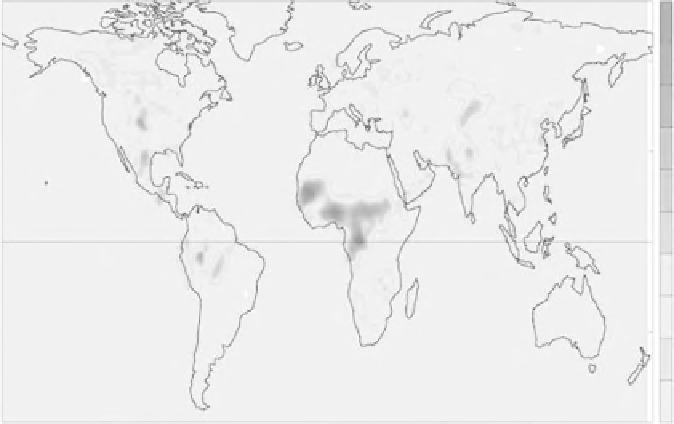Geoscience Reference
In-Depth Information
0.12
0.11
60N
0.10
0.09
30N
0.08
0.07
EQ
0.06
0.05
30S
0.04
0.03
60S
180
180
−
0.03
120W
60W
0
60E
120E
Figure 25.4
Geographical distribution of land-atmosphere 'coupling strength' (i.e., the degree to which anomalies in soil
moisture can affect rainfall generation and other atmospheric processes) averaged for eight GCMs in the GLACE study
(Redrawn from Koster
et al.
, 2006, in which paper 'coupling strength' is defined, published with permission.) See Plate 8 for
a colour version of this image.
precipitation (c.f., Case 3 in Fig. 10.4 and the associated text). Internationally
coordinated GCM studies involving several models have identified regions where
soil moisture control is most important (GLACE; Koster
et al.
, 2006), see Fig. 25.4,
although there are currently some shortcomings in the quality of the representa-
tion of soil moisture evolution in the GCM models used (Teuling
et al.
, 2006).
There is also modeling and some observational evidence that, at least in regions
such as the Sahel (where there are few other surface features such as topography or
heterogeneous land cover) for atmospheric turbulence to respond to, transient soil
moisture heterogeneity can influence mesoscale atmospheric circulations and the
likely location of future rain (e.g., Taylor
et al.
, 2007).
In summary, it is physically plausible that transient changes in soil moisture can
have an impact on weather and climate, and there is a growing body of convincing
evidence that such an impact does occur especially at regional scales, although
currently there is less evidence for the existence of mesoscale influences.
Consequently in Table 25.1 the credibility of this influential mechanism is given as
'extremely likely' at regional scale and 'likely' at mesoscale. However, hitherto
measurement of area-average soil moisture at scales appropriate for accurately
quantifying, building and testing models of the influence of transient changes in
soil moisture has inhibited progress in this area, and the assessment of quantifica-
tion and modeling is given as 'medium' for both regional scale and mesoscale in
Table 25.1 for this reason. Fortunately, new methods for measuring mesoscale
area-average soil moisture are emerging by observing the field of aboveground





